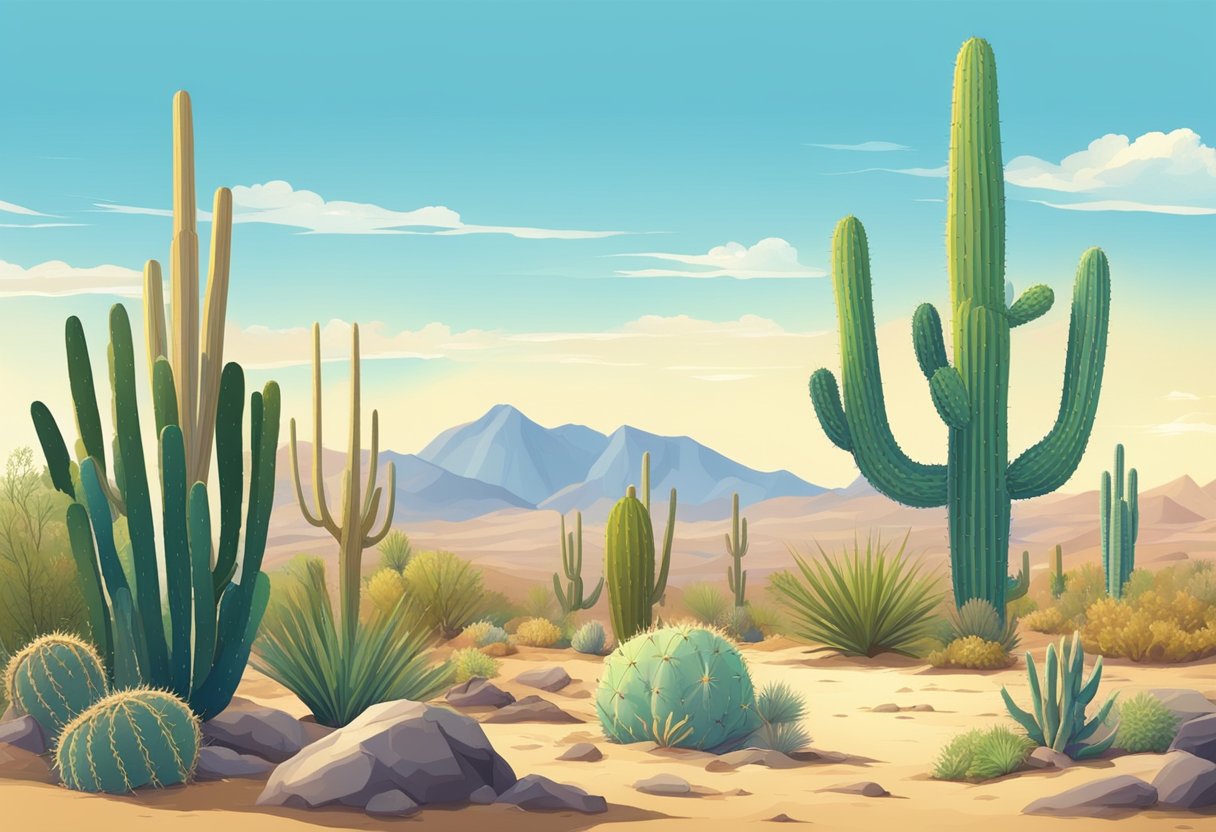Types Of Cacti
Cacti are fascinating plants that have adapted to thrive in some of the harshest environments on Earth. They are known for their unique shapes, beautiful flowers, and ability to store water. There are over 2,000 species of cacti, each with their own distinct characteristics and adaptations. In this article, we will explore the different types of cacti, their habitats and distribution, morphology and adaptations, notable genera and species, their cultural significance, and how to care for them.
Cacti are primarily found in arid regions such as deserts, but they can also be found in other environments such as forests and grasslands. They are native to the Americas, from Canada to South America, and are especially common in Mexico. Cacti have evolved to survive in these harsh environments by developing unique adaptations such as the ability to store water in their thick stems, leaves, or roots. These adaptations allow cacti to survive periods of drought and extreme temperatures.
Cacti are a type of succulent, which means they store water in their tissues to survive in dry environments. They come in a wide variety of shapes and sizes, from small, round cacti to tall, columnar cacti that can grow up to 50 feet tall. Some cacti are covered in spines, while others have no spines at all. Some cacti produce beautiful flowers in a wide range of colors and shapes. The diversity of cacti makes them a popular choice for collectors and gardeners alike.
Key Takeaways
- Cacti are succulent plants that have adapted to thrive in arid environments.
- There are over 2,000 species of cacti, each with their own unique characteristics and adaptations.
- Cacti are popular among collectors and gardeners due to their diverse shapes, sizes, and beautiful flowers.
Cacti Habitats and Distribution

Cacti are a unique family of plants that are known for their ability to thrive in dry and arid environments. They are found in a variety of habitats, ranging from the deserts of North and South America to the tropical rainforests of Central and South America. In this section, we will explore the different habitats and distributions of cacti.
South America
South America is home to a diverse range of cacti species. The Andes Mountains, for example, are home to several species of columnar cacti, including the Echinopsis genus. These cacti can grow up to 40 feet tall and are known for their beautiful flowers. The Atacama Desert, located in Chile, is one of the driest places on earth and is home to several species of cacti, including the Copiapoa genus.
Sonoran Desert
The Sonoran Desert is located in North America and is known for its hot and dry climate. It is home to several species of cacti, including the Saguaro cactus. The Saguaro cactus can grow up to 60 feet tall and is known for its distinctive shape. It is also home to several species of barrel cacti, including the Ferocactus genus.
Mexico
Mexico is home to a wide variety of cacti species, including the Mammillaria genus. These cacti are known for their small size and beautiful flowers. Mexico is also home to several species of columnar cacti, including the Carnegiea genus. The Carnegiea genus is known for its tall, slender shape and can grow up to 60 feet tall.
Overall, cacti are a fascinating family of plants that are well adapted to dry and arid environments. They can be found in a variety of habitats around the world, but are most commonly found in the deserts of North and South America. Whether you are interested in their unique shapes or beautiful flowers, cacti are sure to capture your attention.
Morphology and Adaptations
Cacti are a unique group of plants that have adapted to survive in arid and semi-arid environments. Their morphology and adaptations have allowed them to thrive in conditions where other plants cannot, making them a fascinating subject of study for botanists and plant enthusiasts alike.
Stem and Areoles
One of the most distinctive features of cacti is their stem. Unlike most plants, cacti have a succulent stem that is capable of storing water for long periods of time. This allows them to survive in environments where water is scarce. The stem of a cactus is also covered in areoles, which are small, round, raised areas from which spines, flowers, and new stems can grow.
Spines and Glochids
Spines are another defining characteristic of cacti. These sharp, pointed structures grow from the areoles on the stem and serve a variety of purposes. Some spines are used for protection against predators, while others help to reduce water loss by shading the stem from the sun. Some cacti also have glochids, which are small, hair-like structures that grow in clusters on the areoles. These can be irritating to the skin and are used as a defense mechanism against herbivores.
Flowers and Fruits
Cacti produce some of the most beautiful flowers in the plant kingdom. These flowers are often large and brightly colored, and they are an important source of food for pollinators such as bees and hummingbirds. Cacti also produce a variety of fruits, including berries, which are an important food source for animals in the desert.
Overall, the morphology and adaptations of cacti have allowed them to thrive in some of the harshest environments on Earth. From their succulent stems to their sharp spines and beautiful flowers, cacti are a testament to the amazing diversity of life on our planet.
Notable Cacti Genera and Species
Opuntia and Prickly Pears
Opuntia, commonly known as prickly pears, is a genus of cacti that includes over 200 species. They are known for their flat, paddle-shaped stems covered in spines and small, colorful flowers. Prickly pears are found throughout the Americas, from Canada to Argentina, and are commonly used for food, medicine, and ornamental purposes. The most well-known species of Opuntia is the prickly pear cactus, which produces edible fruit and is often used in Mexican cuisine.
Carnegiea and Saguaro
Carnegiea, commonly known as saguaros, is a genus of cacti that includes only one species, the saguaro cactus. This iconic cactus is found in the Sonoran Desert of Arizona, California, and Mexico, and is known for its tall, columnar shape and distinctive arms. Saguaros can live for over 150 years and are a symbol of the American Southwest.
Mammillaria and Pincushion Cacti
Mammillaria is a genus of cacti that includes over 200 species. They are known for their small, round shape and dense clusters of spines. Mammillaria cacti are found throughout North and South America and are popular in the ornamental plant trade. The most well-known species of Mammillaria is the pincushion cactus, which produces bright, colorful flowers.
Echinocactus and Barrel Cacti
Echinocactus is a genus of cacti that includes over 20 species. They are known for their barrel-shaped stems covered in spines and large, showy flowers. Echinocactus cacti are found throughout North and South America and are popular in the ornamental plant trade. The most well-known species of Echinocactus is the barrel cactus, which is often found in arid regions and can live for over 100 years.
Overall, these genera and species of cacti are just a few examples of the diversity and beauty of this unique group of plants. From the old lady cactus to the moon cactus, star cactus, and hedgehog cactus, there are countless other species of cacti that are worth exploring and appreciating.
Cacti in Culture and Symbolism
Cacti have been an essential part of various cultures and symbolize different meanings across the world. In this section, we will explore the cultural significance and symbolic meanings of cacti.
Cacti as Houseplants
Cacti are popular houseplants, and their ability to thrive in dry environments makes them a perfect choice for people who live in arid regions or those who do not have time to water their plants regularly. Schlumbergera, also known as Christmas cactus, is a popular type of cacti that blooms during the winter season, making it a perfect choice for holiday decorations. The Easter cactus and Thanksgiving cactus are other types of cacti that are popular as houseplants.
Symbolic Meanings
Cacti hold significant symbolic meanings in different cultures. In Native American cultures, cacti represent resilience, protection, and endurance. The ability of cacti to survive in harsh desert conditions symbolizes strength and adaptability. In Latin American cultures, cacti are a symbol of the arid landscapes and the vibrant and enduring culture of the region.
Different colors of cactus flowers also hold symbolic meanings. Pink or orange flowers on a cactus symbolize youth and beauty, while green flowers represent good luck. Blue cactus flowers represent loyalty and faithfulness, and a cactus with red flowers is often given as a birthday gift to symbolize well-wishing, longevity, and good health.
In conclusion, cacti have a rich cultural history and hold significant symbolic meanings across various societies. As houseplants, they are easy to care for and add a unique touch to any living space.
Caring for Cacti
Cacti are easy to care for and make great houseplants. They are succulents, which means they store water in their leaves, stems, and roots. This allows them to survive in arid environments, but also makes them susceptible to overwatering. Here are some tips on how to care for your cacti:
Watering and Light Requirements
Cacti need bright, direct sunlight to thrive. Place them near a sunny window or under a grow light for at least 6 hours a day. Be careful not to expose them to too much direct sunlight, as this can cause sunburn.
When it comes to watering, less is more. Cacti are adapted to survive long periods of drought, so they only need to be watered once every 2-4 weeks. When you do water them, make sure to give them a good soak and then allow the soil to dry out completely before watering again. Overwatering can cause the roots to rot and eventually kill the plant.
Propagation and Grafting
Cacti can be propagated from seeds or cuttings. To propagate from cuttings, simply cut off a piece of the stem and allow it to dry for a few days. Then, plant the cutting in well-draining soil and water sparingly until it begins to root.
Grafting is another method of propagation that involves combining two different cacti to create a hybrid. This is done by cutting off the top of one cactus and attaching it to the rootstock of another. The two plants will eventually fuse together and create a new, unique cactus.
In conclusion, cacti are easy to care for and make great houseplants. They only need bright, direct sunlight and infrequent watering. Propagation can be done through seeds or cuttings, while grafting can create unique hybrids. With these tips, you can enjoy your cacti for years to come.






